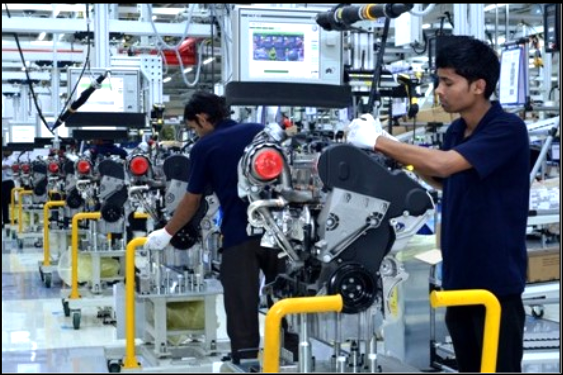
GS3 - Economy
A Roadmap for the Future
Introduction
In today's interconnected world, India is stepping onto the global stage as a significant player in the economy.
With the COVID-19 pandemic reshaping industries and supply chains, the time has never been more opportune for India to realize its potential and become a world leader in the post-pandemic era. According to a FICCI-McKinsey report, India is poised to achieve remarkable economic growth by 2047, but the journey is not without its challenges. In this blog, we'll delve into the key factors and initiatives that can propel India into the league of global manufacturing leaders.
Section 1: Policy Making in India
Recent policy reforms in India have set the stage for industrial growth. These include the introduction of the Goods and Services Tax (GST), the National Single-Window System, and production-linked incentive (PLI) schemes. These reforms have created an environment conducive to manufacturing, making it easier for businesses to thrive and grow.
One of the standout features of these reforms is their job creation potential. Manufacturing has the highest potential to generate 60 million to 70 million jobs by 2030. This not only signifies economic growth but also the empowerment of India's vast workforce.
Additionally, the government's initiatives like PM-Gati Shakti and the National Logistics Policy have provided the necessary infrastructure and logistics support, fostering an ecosystem where manufacturing can flourish. These initiatives enable smoother and more efficient movement of goods, reducing bottlenecks in the supply chain.
Section 2: India's Ascent in Manufacturing
India's aim to boost real GDP growth in manufacturing from 7-8% (as of 2022) to 9-10% signifies its ambition to be a global manufacturing powerhouse. The nation has made significant strides in sectors like mobile phones, Advanced Chemistry Cell (ACC) batteries, high-efficiency solar PV modules, and drones. For example, India has become the world's second-largest mobile phone producer, with smartphones now accounting for more than $11 billion in exports.
To bolster this growth, India is strategically positioning itself in key global value chains, focusing on electronics, chemicals, medical devices, and more. Developing specialized clusters, like the Mumbai—Thane—Raigad cluster for electronics and chemicals, is a step towards achieving this goal. State governments are also joining the effort by creating plug-and-play cluster zones based on their manufacturing strengths.
The push for 'Make in India' has not only led to the growth of domestic manufacturing but also transformed India into a global manufacturing hub. Supported by favorable policies and incentives, India's manufacturing sector is becoming increasingly competitive on the international stage.
Section 3: The Digital Revolution in Manufacturing
India's manufacturing sector is embracing the digital revolution, with substantial investments in Industry 4.0 technologies such as the Internet of Things (IoT), artificial intelligence (AI), big data analytics, and robotics. This digital transformation promises increased reliability and supply chain resilience, along with the potential for 'smart manufacturing.' The ongoing rollout of 5G technology is set to play a pivotal role in this transformation, facilitating connected asset monitoring, predictive maintenance, and more.
However, achieving this digital future necessitates a skilled workforce. India must invest in skill development programs and collaborate with educational institutions and industry bodies to bridge the skills gap. Furthermore, incentivizing technological investments, boosting research and development (R&D), and expanding institutional capacity will expedite India's industrialization.
The integration of digital technologies into manufacturing processes not only enhances efficiency but also positions India as a forward-thinking and technologically advanced manufacturing destination.
Section 4: A Sustainable Manufacturing Future
As sustainability becomes increasingly imperative, Indian manufacturers are embracing eco-friendly practices and green policies. Beyond environmental responsibility, this shift also enhances competitiveness.
Manufacturers are prioritizing green alternatives like bio-based materials and sustainable packaging. Leveraging digital technologies and Industry 4.0 aligns industrial processes with sustainability goals, resulting in efficient, environmentally friendly manufacturing systems.
The adoption of sustainable practices not only caters to the global demand for environmentally conscious products but also ensures the long-term viability of Indian manufacturing.
Section 5: Strengthening Infrastructure
Efficient logistics and infrastructure are vital for seamless goods movement within India's industrial value chains.
Initiatives such as Industrial Corridor Development, PM Gati Shakti Master Plan, and the National Logistics Policy are addressing these challenges. Furthermore, state and central governments are actively participating in strengthening infrastructure through public-private partnerships (PPPs) and special-purpose vehicles. The development of smart cities and plug-and-play infrastructure is also on the horizon.
A robust infrastructure not only reduces operational costs for manufacturers but also enhances the country's overall competitiveness as a manufacturing destination.
Conclusion: The Way Forward
India has made significant strides in simplifying its policy and regulatory framework to encourage business growth. Ongoing reforms will continue to pave the way for an efficient, productive, sustainable, and export-focused industrial sector. As India charts its course towards manufacturing leadership in the global arena, it must seize the opportunities presented by policy reforms, digital transformation, sustainability, and robust infrastructure development.
The future of Indian manufacturing looks promising, with the potential to not only meet domestic demand but also to become a major player in international markets. With concerted efforts from both the public and private sectors, India can claim its place as a global manufacturing powerhouse in the post-Covid New World Order.
